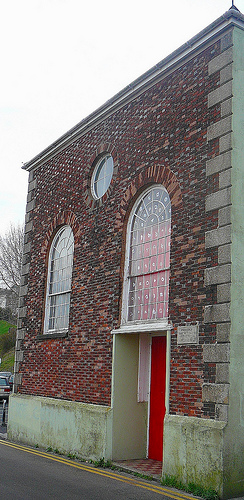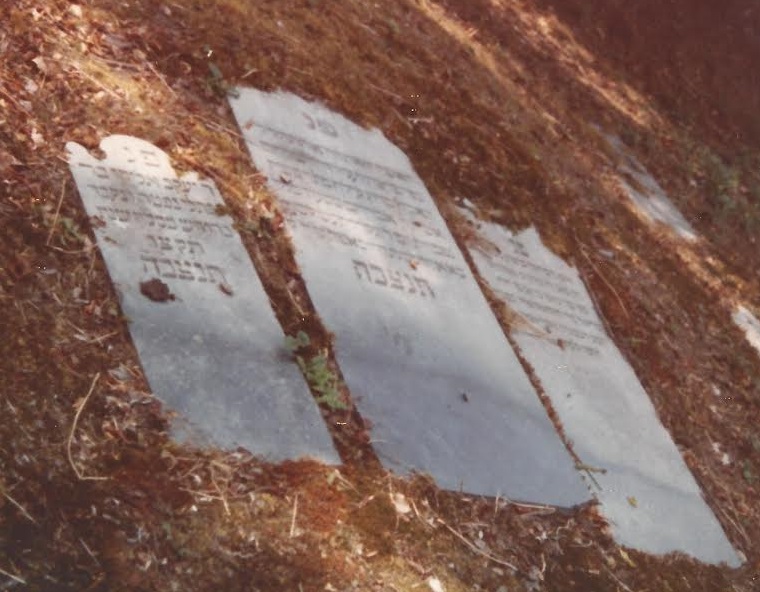|
JCR-UK is a genealogical and historical website covering all Jewish communities and
congregations
throughout the British Isles and Gibraltar, both past and present.
Town of Falmouth
Falmouth, a port on the south coast of Cornwall in southwest England, has a population of about 20,000.
It was a municipal borough until 1974, when it was merged with
neighbouring localities to form the local government (non-metropolitan) district of Carrick.
In April 2009, the district of Carrick and all other local government districts
in Cornwall were abolished, and Cornwall became a unitary authority.

The former Falmouth Synagogue
© Tim Green
The
Falmouth Jewish Community
Jews began settling in Falmouth from at least the 1720s, and the community was
established in 1740, at which time Falmouth was an important and
flourishing port carrying on trade with the West Indies, Portugal and southern
Africa. The Jewish community also flourished through the eighteenth century until
the middle of the nineteenth century when numbers began to dwindle and, by the latter
part of that century, the community had ceased to exist.
One of the principal works covering the community is The Lost Jews of
Cornwall (2000), edited by Keith Perace and Helen Fry with Geoffrey
Simmons as consultant (which we refer to here as "The Lost Jews"), which was
largely republished and enhanced in 2013 as
The Jews of Cornwall, A History, Tradition and Settlement to 1913 by Keith Pearce.
|
Congregation Data
|
|
Name:
|
Falmouth Jewish Congregation
|
|
Address:
|
1
Gyllyng Street, Smithick Hill (or Parram Hill),
Falmouth TR11 3EH,(iv)
initially known as Fish Street Hill.(v)
The synagogue was purpose-built, constructed in 1806 or 1808(vi)
It is a Grade II Listed
Building, listed on 1 October 1975 (number 1270005).
See Historic
England Listing & Description.
The
synagogue was previously (from 1766) at
Hamblyn's Court (later Dunstan's or Jeffery's Court),(vii)
near the harbour on the site of the later gas works.
|
|
Formation:
|
Community was established by Moses Alexander
(later known as Zender Falmouth) in 1740,(x)
and the first synagogue acquired in 1766.
|
|
Closure:
|
The synagogue closed about
1880, when Samuel Jacob, who had until then kept the
synagogue open for services and whose family had been
the mainstay of the congregation, left with his family
for London,(xi) the last minister having also left the
community.
In 1892, the synagogue
building (then known as "Synagogue House") was sold on
the order of the Chief Rabbi to the trustees.(xii)
It was converted into a flat and studio (known as Summerhill
Studio).(xiii)
|
|
Ritual:
|
Ashkenazi Orthodox
|
|
Affiliation:
|
The congregation was an
unaffiliated congregation under the aegis of the Chief
Rabbi.
|
|
Ministers:
(To view a short profile of a minister whose name appears in blue, hold the cursor over his name.)
|
Little is known of the the early ministers of the
congregation.
Rev. Isaac Polak
- may have served as a minister/reader in 1760s.(xvii)
Rev. Samuel ben Samuel HaLevi
("Rabbi Saavill") - dates uncertain.(xviii)
Rev. Moses Hyman
(Rev. Moses ben Hayyim) - reader from
at least 1815 until about 1830.(xix)
Rev. Joseph Benedict Rintel
- minister from about 1832 until 1849.(xx)
Rev. Samuel Herman
- minister about 1851 until about 1860.(xxi)
[
Rev. David Herman - the son of Rev.
Samuel Herman, who reportedly served as minister in 1852.(xxiv)
Rev. Marks Morris
- minister from about 1860 to about 1864.(xxv)
Rev. Abraham Abelson
- minister from about 1868 to about 1871.(xxvi)
Rev. Nathan Lipman
- minister from about 1871 until 1875.(xxvii)
Rev. Samuel Orler
- minister from 1875 until 1880.(xxviii)
|
|
Presidents of the Congregation:
|
Alexander Moses
(1715-1791), known as Zender Falmouth, is
considered the founder
of the community (c.1740) and the effective president of the congregation
until his death in 1791.(xxx)
Moses Jacob
(1733-1807), son-in-law of Zender Falmouth (husband of his
sister, Sarah Moses) was president from 1791 until his
death in 1807.(xxxi)
Lyon Joseph
(1775-1825) was parnas (president) from 1807 until 1815.(xxxii)
Jacob (John) Jacob
(1774-1853), son of Moses Jacob, was president from
about 1816 until his death in 1853.(xxxiii)
Moses "Moss" Jacob
(1813-1860), son of Jacob (John) Jacob, was president from 1853 until
his death in 1860.(xxxiv)
Samuel Jacob
(1837-1912), son of Moses "Moss" Jacob, was president from 1860
until he left the community and the synagogue closed in 1880.(xxxv)
|
|
Membership Data:
|
General
1845 - 9 ba'alai batim and 3
seatholders (Chief
Rabbi's Questionnaire)
Number of Seatholders - Board of Deputies Returns(xxxviii)
1852 - 3 seatholders
1860 - 2 seatholders
|
|
Registration District:
|
Cornwall, since 1 May
2007(xxxix)
-
Link to Register Office website
|
|
Online Articles and Other
Material
relating to the Falmouth Jewish Community
on JCR-UK
-
Susser Archives:
-
Provincial Jewry in Victorian Britain - Papers for a conference
at University College, London, convened by the Jewish Historical Society
of England, prepared by Aubrey Newman - 6th July 1975.
-
Material relating to the Falmouth Jewish Cemetery, see
below.
-
Jewish Listed Heritage Sites in Cornwall.
-
Bibliography.
on Third Party Websites
|
|
Falmouth Jewish Cemetery Information

Courtesy Len van der Put, 1982
Falmouth had its own Jewish cemetery:
-
Falmouth Jews' Burial Ground,
A39 Falmouth Road, Penryn, Ponsharden, Falmouth TR10 8AB.
The burial ground was established about 1780 when the
plot of land was presented to the Jewish community by Lord de
Dunstanville (who also presented an adjoining plot to the Christian
Non-Conformists. The cemetery contains over
50 recorded burials, of which over 30 have in-situ legible gravestones.
The earliest in-situ gravestone is dated 1790 and the
latest 1868, apart from a burial in 1913, long after the
Falmouth Jewish community had dispersed. The cemetery is one of the disused cemeteries
administered by the Board of Deputies of British Jews.
The cemetery is a Scheduled Monument, listed from
17 October 2002 (latest amendment 20 December 2019 (number 1020815).
See Historic England Listing & Description
|
|

Courtesy
Len van der Put, 1982
|
Articles and other material on JCR-UK:
Tombstone Inscriptions at Falmouth Jewish Cemetery, transcribed by Rabbi
Dr. Bernard Susser (a section of Rabbi Susser's "Jewish Tombstone Inscriptions in S.
W. England - Studies in Anglo-Jewish History No. 3", which includes an
Introduction that also makes reference to Falmouth).
Part of the Susser Archive.
Under the heading "Irreplaceable: A History of England in 100 Places",
the ecclesiastical.com
website lists 10 places "that have witnessed some of the most important historic events connected to a belief; mythological, supernatural or spiritual",
which list includes Falmouth Jewish Cemetery, along with the likes of Stonehenge, Canterbury Cathedral and Holy Island of Lindisfarme, along
with Brick Lane Mosque (formerly
Machzike Hadath's Spitalfield Great Synagogue).
(For additional information, see also
IAJGS Cemetery Project - Falmouth)
|
|
Falmouth Jewish Population Data
|
|
Year
|
Number |
Source |
|
1842
|
14 families |
(Jewish Chronicle 18 Marh 1842) |
|
1847
|
9 heads of family
(50 individuals) |
(Jewish Chronicle 23 July 1847) |
|
1874
|
3 families |
(Jewish Directory for 1874 by A.
Myers) |
|
Notes & Sources
(↵
returns to text above)
|
|
|
Jewish Congregations in
Cornwall
Jewish Communities of England homepage
Page created: 6 October 2005
Data significantly expanded: 11 March 2016
Data
further expanded and notes first added: 7 November 2023
Page most recently amended: 14 November 2023
Research and
formatting by David Shulman
Explanation of Terms |
About JCR-UK |
JCR-UK home page
Contact JCR-UK Webmaster:
[email protected]


Terms and Conditions, Licenses and Restrictions for the use of this website:
This website is
owned by JewishGen and the Jewish Genealogical Society of Great Britain. All
material found herein is owned by or licensed to us. You may view, download, and
print material from this site only for your own personal use. You may not post
material from this site on another website without our consent. You may not
transmit or distribute material from this website to others. You may not use
this website or information found at this site for any commercial purpose.
Copyright © 2002 - 2025 JCR-UK. All Rights Reserved
|
|





